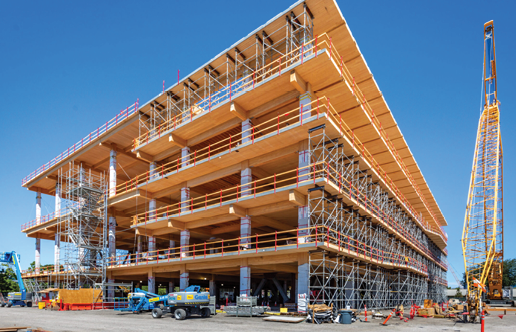
Context’s Senior Registered Architect and Urban Designer Dan Branda recently visited San Francisco to experience first-hand how mass timber construction is being adopted in the United States. Here he discusses the need for New Zealand’s construction sector to accelerate change, collaborate and consider how mass timber can drive a more sustainable approach to building.
As New Zealand strives to build a sustainable and resilient future, the adoption of mass timber in the construction industry is being heralded as a game-changer. Mass timber, known for its structural strength, environmental benefits, and aesthetic appeal, presents a unique opportunity for New Zealand to gain traction in sustainable building practices.
Traditionally, slow to adapt to change, we are lagging behind some of the more forward-thinking countries around the globe when it comes to exploring new sustainable building methods. While the government has introduced the Building Climate Change and has legislated for the reduction of whole-of-life carbon emissions of buildings, the industry hasn’t been quick to look beyond traditional building techniques.
Mass timber is renowned for its low carbon footprint compared to traditional construction materials such as concrete and steel. It reduces greenhouse gas emissions by sequestering carbon dioxide during the growth of the timber and replacing more carbon-intensive materials. By transitioning to mass timber, we can significantly contribute to achieving our climate change mitigation goals and support the nation’s commitment to a carbon-neutral future.
Our geographical location exposes New Zealand to the risk of earthquakes. Mass timber, with its inherent flexibility and lightweight properties, offers exceptional seismic resilience. It can withstand and dissipate seismic forces through its engineered strength and ability to absorb and distribute energy. Embracing mass timber in construction projects will contribute to creating safer buildings that can better withstand seismic events, enhancing the overall resilience of the country’s built environment.
Mass timber construction allows for off-site fabrication, precision engineering, and prefabrication techniques, enabling faster and more efficient construction processes. Compared to traditional methods, mass timber construction can reduce project timelines significantly, leading to cost savings and quicker project delivery. This accelerated construction process can address New Zealand’s urgent need for affordable housing and infrastructure, ensuring faster occupancy and reducing disruption to communities.
The enhanced aesthetic and design possibilities mass timber offers, provides architects and designers with unparalleled opportunities for creativity and innovation in building design. The warmth, natural beauty, and unique texture of timber contributes to creating inviting and inspiring spaces. From residential homes to commercial buildings, mass timber’s versatility allows for the realisation of iconic, sustainable structures that showcase New Zealand’s commitment to design excellence and environmental stewardship.
Moreover, adopting mass timber promotes sustainable forestry practices and local economic growth. By utilising local timber resources, the country can reduce dependence on imported construction materials and strengthen the local economy, generating employment opportunities and fostering regional development.
While mass timber construction undoubtedly has several benefits, there are drawbacks that the industry needs to be aware of. Due to the size of the material, it is more expensive than steel or concrete and requires large rainproof facilities for storage. Higher material transportation costs can also apply and there are relatively few manufacturing plants in New Zealand to be able to keep up with future demand.
For me, the pros far outweigh the cons. What we need to ensure now is that we start to talk and collaborate as an industry. Shane Wyatt – Technical Director, Tech Coatings, who was involved in my recent visit to America said, “Mass timber is inspiring the most recent innovation in the building industry and with that, advancing a change in thinking. A change that is urgently needed, especially in an industry that is so averse to change. More than ever, collaboration and the sharing of knowledge is essential to create a truly beneficial solution.”
If you would like to find out more about mass timber and cross-laminated solutions, send an email to hello@context.nz